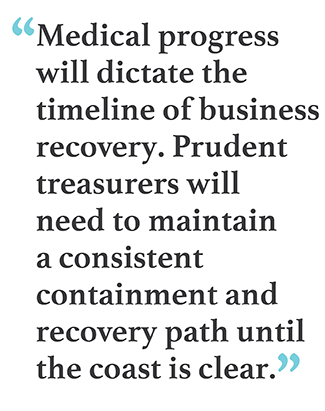
A small consolation in the current state of our virus-stalled economy is that the crisis is evolving from an "unknown unknown" to a "known unknown." Most corporate treasurers and CFOs wield a significant degree of control over their organization's fate. With prudent decisions based on sound risk management, finance executives may be able to navigate their companies elegantly through this crisis, to an eventual recovery.
That is not to say the journey will be easy. The arrival of the coronavirus flung many assumptions out the window.
Recommended For You
We started this decade with strong corporate earnings estimates for 2020 and 2021. The U.S. economy had substantial momentum. Employment and job creation stood at record levels, and U.S. consumers looked resilient. Growth was reasonably steady, and inflation was largely in check, with only a recent marginal uptick above trend. Trade negotiations with China were proceeding in the right direction. Overall, the mood in the financial markets was optimistic.
Then, in late February, markets in the United States suddenly came to grips with the contagion of fear around Covid-19. They froze, then plummeted, and the possibility of a sharp and deep recession became the new baseline scenario. The shuttering of businesses, slowing of production, cannibalizing of employment, and stifling of consumer activity quickly turned the public health crisis into an economic crisis. The situation wreaked havoc with asset prices, causing unprecedented disruption in financial markets, leading to sharp price drops and a significant widening of bid-offer spreads. Transactional activity came nearly to a standstill, especially in fixed-income markets, including even very high-quality securities.
This environment is fundamentally unlike the financial crisis of 2008 to 2009. The coronavirus pandemic is global, and the economic contraction we're currently in was triggered by an exogenous factor—the disease—not by structural financial problems, such as grossly overvalued mortgages, inflated leverage, and falling home prices. The current crisis is more like the market shock that followed 9/11. It was sudden and externally driven, revealing vulnerabilities as it turned excess leverage—combined with significantly reduced liquidity in market transactions—into dislocation in asset valuations and disruption in financial markets.
The economic impact is already more severe than what we suffered in 2001. Fortunately, the economic crisis has not yet precipitated a financial-market crisis, thanks in large part to swift and substantial actions by the Federal Reserve and Congress. The Fed provided unprecedented support to the fixed-income markets—including Treasuries, mortgages, and both corporate and municipal bonds. Congress has funded four waves of stimulus so far.
Common wisdom holds that a lot more stimulus and more efficient pass-through mechanisms, along with time, will be needed to get us back to a somewhat normal and stable economy. Therapeutics, testing, and vaccines will be crucial. The stubborn presence of the virus will limit consumer and business activities, even as governments attempt to reopen their economies. Reducing people's pervasive, justifiable fear will be imperative in order for economic recovery to bloom.
What Now?
Although the markets have partially recovered, they may not have yet hit bottom—and even if they have, prices could well return to "test the lows," as we've seen in past recessions and severe dislocations. In 2008, equity markets initially lagged behind the fixed-income markets in the process of correction.
Maintaining adequate liquidity for the business to run smoothly is more important today than ever before—and for some treasury groups, it's also more challenging. When the crisis hit, some corporate treasurers moved quickly to draw on their backstop revolvers, typically in response to an immediate or anticipated cash-flow crunch, or just to increase the liquidity on hand as they faced the unknown. In my opinion, that was the right thing to do, as the Covid-19 risks were extremely opaque.
The Federal Reserve did the right thing, too, rushing in with the necessary asset-purchase programs in the fixed-income markets, and the pace and scale of action was unprecedented. Treasury rates had been low, corporate credit spreads had moved out, and there had been tremendous demand for bonds. Investment-grade businesses came out to financing, eventually leading to record corporate bond issuance. It was an ideal opportunity for companies to build a cash pool for riding out the Covid-19 crisis. With the signal of Fed support, the high-yield bond market, too, became open for issuance.
 Equities, however, have become complicated. The Covid-19 crisis has created enormous differentiation in outlook; expected resilience level; and revenues, cash flows, and expected returns for stocks within various industries across large, midsize, and small-cap companies. Certain sectors—including travel, entertainment, and hospitality—have been affected by adversity at a shocking pace. Others—such as technology, healthcare, and consumer staples—are holding up much better. Even within a given industry, some companies may be noticeably resilient, while others have been severely shocked. It's hard to pick winners and losers when one can't foretell the duration or depth of this crisis. Will there be a second wave of infections? A perfect storm of Covid-19 and the flu? Dangerous mutations? Food shortages? Post-infection immunity? We just don't have the answers.
Equities, however, have become complicated. The Covid-19 crisis has created enormous differentiation in outlook; expected resilience level; and revenues, cash flows, and expected returns for stocks within various industries across large, midsize, and small-cap companies. Certain sectors—including travel, entertainment, and hospitality—have been affected by adversity at a shocking pace. Others—such as technology, healthcare, and consumer staples—are holding up much better. Even within a given industry, some companies may be noticeably resilient, while others have been severely shocked. It's hard to pick winners and losers when one can't foretell the duration or depth of this crisis. Will there be a second wave of infections? A perfect storm of Covid-19 and the flu? Dangerous mutations? Food shortages? Post-infection immunity? We just don't have the answers.
Corporate treasuries will need to manage their liquidity based on the company's positioning and business model, how it is managing through the crisis, and what its business model will look like post–Covid-19. These factors should inform the treasurer's decisions about the level of risk to accept within the organization's liquidity pool—whether to stick to cash and money-market funds, or to diversify into other short-term investments that could generate an additional 25 to 50 basis points (bps) above zero. Short-term investments could include high-quality commercial paper (CP), as well as other credit-based and low-duration investments. Selecting CP issues for the corporate liquidity portfolio will require an in-depth company-level credit analysis to determine the specific credit risk, both during the Covid-19 crisis and beyond.
Actions to Take
This year's equity volatility, in both directions, has been extreme in both speed and scale. Nevertheless, prudent investors took the high volatility of the fourth quarter of 2018 as a warning sign. As equity valuations hit long-term highs—especially as the S&P 500 finished 2019 with a 31.5 percent return—some asset owners began reducing risk. Those who took this approach experienced less pain in the equity-market plunge of February and March of this year.
Regardless of how prepared they were for the first quarter of 2020, going forward, corporate treasury and investment management teams must understand the risks and opportunities across all the asset classes they invest in. As the chief investment officer for FM Global, I am following three key principles as I steer our corporate portfolio through these tumultuous times:
1. No sudden moves. In a volatile environment, reacting to any given day's news is risky. Through January and most of February, we were managing financial risks in a low-volatility environment where daily equity-market moves of 2 percent in either direction were considered large. March, however, saw daily moves in the neighborhood of 9 percent, both up and down—a sign that the worst on the economic front was yet to come. Today, volatility has subsided significantly, but we're not out of the woods, and it still remains well above the long-term average. The economic situation remains deeply concerning.
2. Always be cautious. The past is past, but corporate investment managers who were cautious early this year are likely in better shape today. Even when the future looks fairly rosy, as it did through early February of this year, it's important to have downside-risk management characteristics and diversification embedded in the portfolio construction, before market volatility can creep in unexpectedly. Building a resilient portfolio requires extensive due diligence focused on limiting the concentration of assets with any particular risk factor—from asset type to geographic region to credit risk. At the same time, strategic construction of a resilient portfolio focuses on asset quality as an important building block. Corporate investment managers who had built such a portfolio would have seen much less decline in asset prices in March than what plagued the broad market indices.
3. Focus on liquidity. Cash on hand is always a focus of corporate treasury teams. Near-term liquidity management requires unconditional availability of the cash pool, stored in cash deposits with financially strong banks, money-market funds (MMFs), and Treasury bills.
Corporate treasurers currently need to be doing everything in their power to establish an adequately large cash pool, replenish it as necessary, and protect it from volatility. The panic in March led asset owners and treasurers to quickly move funds to the safest possible assets, even transferring cash from MMFs to bank accounts. Short-term interest rates had dropped to zero, but the liquidity assurance was crucial.
Reliable, scenario-tested cash-flow forecasting and ongoing stress-testing will help a treasury group determine their liquidity needs. Cash-flow forecasts need to be managed live, or at least on a daily basis. They need to include both base-case and pessimistic scenarios. Where relevant, they should also include marginally optimistic scenarios. To ensure these scenarios are effectively estimating risk, treasury will need to solicit disciplined input from internal partners across the globe and incorporate realistic expectations from external sources.
For corporate investment managers, the challenge is to balance the company's need for adequate liquidity with shareholders' and other stakeholders' expectations in the short and medium term. They need to make sure that the existing and available liquidity pool will continue to meet stress-tested cash requirements over the next 12 to 18 months. At the same time, they should weigh in on decisions around maintaining, reducing, or temporarily suspending dividends and/or share buyback programs, because these outflows can substantially impact the business's liquidity needs.
Back to Basics
This is not the time for broad-based risk taking. To the contrary, treasurers need to eliminate material unintended risks in their function's day-to-day operations that could jeopardize cash flows. The focus needs to be on "back to basics"—i.e., ensuring that treasury will meet its primary objective of maintaining adequate liquidity and keeping the cash pool replenished as business needs evolve.
In addition, the treasury team needs to be vigilant in their monitoring and management of financial risks, including foreign exchange, interest rate, and credit risks. It is also extremely important to ensure a seamless and secure operations and treasury systems environment, given the increase in cyber risks, and to strengthen the focus on enterprisewide risk management.
See also:
- Money Fund Madness in March
- Who Will Thrive in the Coming Deflation?
- Gary Shilling: Recession Will Last into 2021
- Assessing the Impact of the Fed's Interest Rate End Game
- Emerging Risks: Get Ahead of the Unexpected
Counterparty risk assessment and risk management are always important building blocks in treasury operations risk management. Fortunately, the banking system today is very strong, unlike in the 2008 crisis. Companies should be able to rely on stable, highly regulated financial institutions to meet their obligations for the foreseeable future, and cash deposits are in a much more secure framework versus the banks in 2008.
In addition, lending relationships with large conglomerate banks are more reliable, as has been demonstrated with the recent draws on revolving credit facilities. Nevertheless, if the crisis extends much beyond expected timelines, the lack of economic activity may test the resilience of some financial institutions. Therefore, it will remain important to closely monitor counterparty risk assessment for cash deposits and any over-the-counter (OTC) transactions related to treasury financial risk management.
Final Thoughts
Although the pandemic started as a global health crisis, and very quickly became an economic crisis, policymakers in the world's leading economies have worked to prevent the current situation from becoming a global financial crisis. With monetary support and fiscal stimulus, an absolutely unknown unknown has become something of a known unknown. What is known is that the global economy has entered a downturn which looks very likely to become a deep recession, that liquidity is critical to survival in this environment, and that policymakers in major developed economies remain inclined to mitigate some of the negative impact, as realistically feasible.
As countries look to gradually open their economies for business, the speed and efficacy of medical progress to contain the virus (still an unknown) will dictate the timeline of business recovery. Prudent investors, treasurers, and other financial decision-makers will need to maintain a consistent containment and recovery path until the coast is clear.
The economy and the financial markets will recover, and they will come out much stronger in the medium to long run, as they did after 9/11. Until that time, corporate treasury and finance groups just need to ensure that we navigate the financial market volatility and global economic challenges in a prudent manner. Treasurers need to be focused on continued liquidity management, risk aversion, and risk management to navigate through the current crisis. Any major decisions need to be evaluated with caution, conservatism, and the long-term horizon in mind.
That much is known.
 Sanjay Chawla is chief investment officer of FM Global, one of the world's largest commercial property insurers, which serves many Fortune 1000 companies.
Sanjay Chawla is chief investment officer of FM Global, one of the world's largest commercial property insurers, which serves many Fortune 1000 companies.
